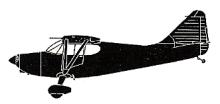
ASN Wikibase Occurrence # 291793
This information is added by users of ASN. Neither ASN nor the Flight Safety Foundation are responsible for the completeness or correctness of this information.
If you feel this information is incomplete or incorrect, you can submit corrected information.
| Date: | Tuesday 19 September 2006 |
| Time: | 10:40 LT |
| Type: |  Stinson 108 |
| Owner/operator: | Private |
| Registration: | N97651 |
| MSN: | 108-051 |
| Total airframe hrs: | 1864 hours |
| Engine model: | Franklin 6A4-165-B3 |
| Fatalities: | Fatalities: 0 / Occupants: 1 |
| Aircraft damage: | Substantial |
| Category: | Accident |
| Location: | Holladay, Tennessee -
 United States of America United States of America
|
| Phase: | Unknown |
| Nature: | Private |
| Departure airport: | Morristown-Moore Murrell Airport, TN (KMOR) |
| Trenton-Gibson County Airport, TN (KTGC) | |
| Investigating agency: | NTSB |
| Confidence Rating: |
The airplane nosed over during a forcd landing after a loss of engine power. The pilot stated he was in cruise flight at 3,500 feet when the engine lost power, "just like it was running out of fuel." The pilot immediately switched the fuel selector valve from the right main fuel tank to the left main fuel tank, applied carburetor heat, and checked that the mixture was full rich. He attempted two engine restarts which were unsuccessful. The pilot observed a forced landing area to his left and entered left traffic to a bean field. While on final approach the pilot moved the fuel selector valve to the off position. The airplane touched down, rolled about 50 feet and nosed over inverted. The airplane was turned over by recovery personnel and examined by the FAA. The upper fuselage and vertical stabilizer received structural damage. Two gallons of fuel was present in the left wing fuel tank and there was evidence of fuel leakage at the accident site. The right main fuel tank had traces of fuel and there was evidence of leakage at the crash site. The airplane was transported to Salem, Indiana, for further examination by the FAA. A differential compression test was performed on the engine and verified the compression test preformed in Tennessee. The No. 2, No. 3, and No. 6 rocker covers were removed and the propeller was turned by hand. Crankshaft and connecting rod movement was observed; however no movement of the camshaft was observed during the crankshaft rotation. The accessory case was removed and the crankshaft gear (P/N 17725), which drives the camshaft gear was found in two pieces. The crankshaft gear had failed at the two keyway slots. A small portion of one key was separated and dislodged from its location in the crankshaft and was found in the engine breather, with the major portion of the key remaining in the crankshaft. The other keyway was damaged. The crankshaft gear pieces and key pieces were forwarded to the NTSB Materials Laboratory Division in Washington, D.C. for further analysis. Examination of the components revealed that one of the fracture surfaces on the crankshaft gear displayed features consistent with fatigue initiating in a corner of one of the keyways. Further examination revealed a small radius had been cut into the larger radius of the keyway and created a location for operational stresses to concentrate. The fracture of the other keyway displayed features consistent with an overload event.
Probable Cause: A total loss of engine power in cruise flight due to the fatigue failure of the crankshaft gear resulting in a forced landing and subsequent nose over.
Accident investigation:
 |
|
Sources:
NTSB ATL06LA127
Revision history:
| Date/time | Contributor | Updates |
|---|---|---|
| 07-Oct-2022 19:01 | ASN Update Bot | Added |
Corrections or additions? ... Edit this accident description
The Aviation Safety Network is an exclusive service provided by:


 ©2024 Flight Safety Foundation
©2024 Flight Safety Foundation